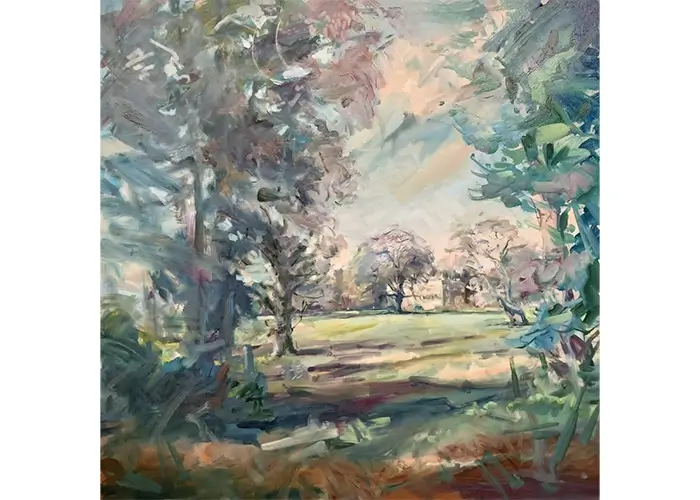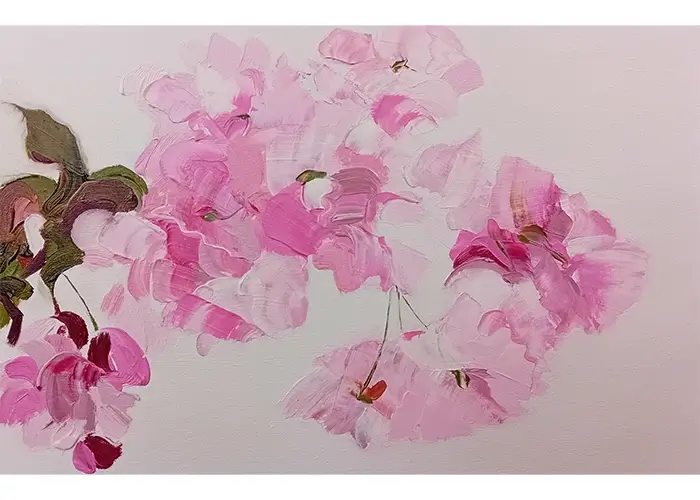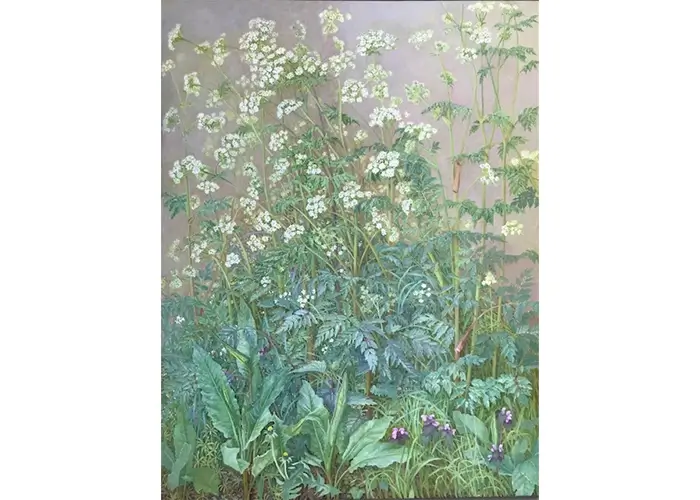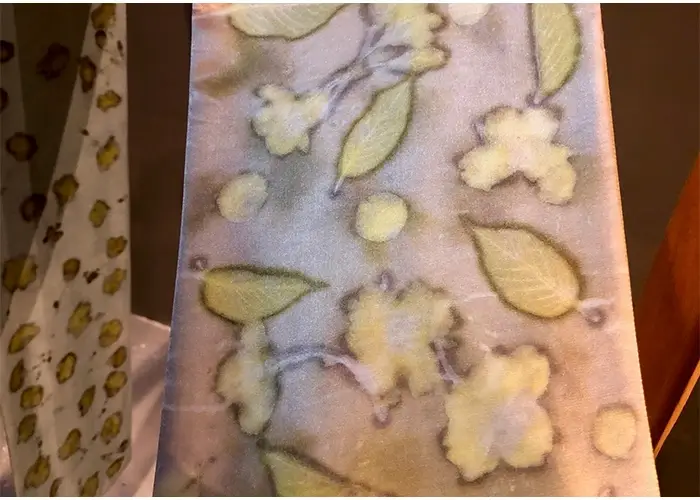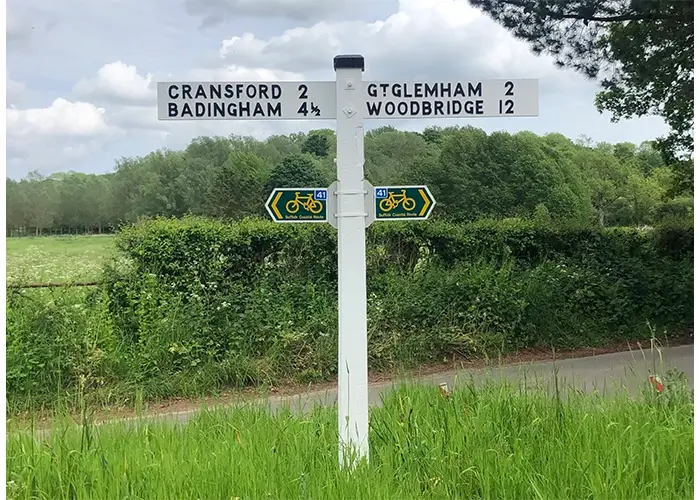The 2025 Alde Valley Spring Festival
Celebrating Food, Gardening, Landscape & the Arts
White House Farm, The Grove, Great Glemham, Suffolk IP17 1LS
FESTIVAL THEME
Learning from a Landscape
~
A Celebration of The Upper Alde Valley & Vale of Great Glemham
~
OPENING TIMES
10am – 6pm
Sat 3rd + Sun 4th + Mon 5th May
+
10am – 6pm
Fri 9th + Sat 10th + Sun 11th May
~
~
INTRODUCTION
We are delighted to return to a short seasonal Alde Valley Spring Festival for 2025. Although the programme and duration of this year’s Festival are smaller than they were pre-covid, the content feels really very precious – and a stepping stone to a larger programme in 2026.
As in previous years, all the paintings and textiles that we are presenting as part of this year’s Spring Festival Exhibition are the fruits of our land-based residency programme. All are being exhibited for the first time and are rooted in the landscape of the beautiful Vale of Great Glemham and adjoining Upper Alde Valley.
Our theme of Learning from a Landscape explores the idea that identity is linked to landscape and that both the land itself and a sense of place can be powerfully revived if we try to observe our surroundings more thoughtfully, discerning what makes them beautiful and what helps them flourish, for both people and wildlife.
Field shapes; the number of plants in a hedgerow; the type of trees in a wood; the depth of soil and the debris found within it; the distribution and age of buildings and the plants found in gardens or on nearby ground : all these things are part of a landscape’s character and can reveal much about its past uses and history.
Looking at the land more carefully can also guide us towards more sensitive ways of working with it: ones that are more socially, ecologically and economically enriching. It feels like artists and craft workers, writers and musicians, farmers, gardeners and conservationists all have an important role to play in this process of observation and planning, by allowing us to see the world or our immediate surroundings from other perspectives.
~
THE VALE OF GREAT GLEMHAM
The content below presents an introductory glimpse of the exhibitions that we are welcoming to the farm in May 2025. All of the artists we are currently working with start by standing in front of their subject or gathering raw materials and inspiration from the landscape in which they are working. They have placed their feet on the ground, be it in a ploughed field, a meadow, an orchard, a garden, wood or lane in the upper reaches of the Alde Valley of East Suffolk.
This is a landscape setting that is rich in wildlife. It is, for Suffolk, also surprisingly hilly. Small valleys drift up from the main run of the River Alde, each with its own soils and gentle topography. One of the most distinctive sub-catchments of the Upper Alde Valley is the Vale of Great Glemham. Once the home of the poet George Crabbe, this small pocket of East Suffolk coutryside enfolds its own little cluster of streams, ditches and former springs. It is a landscape unto itself and for several centuries has been an intermittent home for the visual arts, music and rural writing -alongside the more expansive and labour intensive seasonal rhythms of farming.
It is also a very familiar landscape – one that has been much trodden and well-worked in the past : by people walking to and from work, or visiting neighbours; by livestock and horses, carrying riders or pulling farm carts and implements; by more modern farm machinery and gardeners; and poets and writers; and, more recently, by the many artists and craft workers with whom we have been fortunate to work over the past decade through multi-year residency collaborations.
All of the residencies that we are working on at the moment are intended to help re-kindle of a sense of closeness to the land, be it farmed, gardened or wild. And it is this closeness to the earth – to its soil and its elements – that feels so very precious at this time. We hope to see you at the farm over the first two weekends in May.
Jason Gathorne-Hardy. [Festival Director and Curator.]
White House Farm, Great Glemham.
~
RESIDENCY ARTISTS
Please read on for an introduction to each of the residency collaborations that we are working on at the moment. Our 2025 Festival Exhibitions represents the first harvest of the year for each of them : a gathering in of new works from the fields, woods, gardens and cherry glades at the farm and in the adjoining Vale of Great Glemham. We have adopted a long-read approach for the website content, so please take time to sit back and enjoy the introductions that follow for each artist and their residency.
~
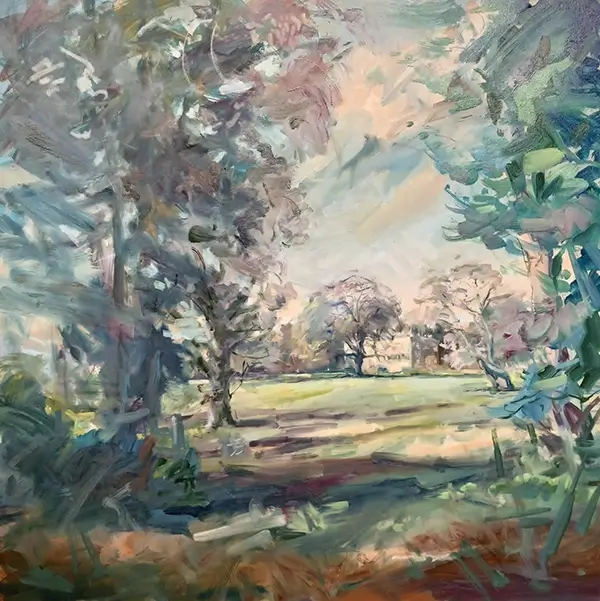
IAN SEDGE
A New Arcadia
This new collaboration with the landscape painter Ian Sedge grew out of a Christmas Exhibition we held at the farm in December 2024. I had been aware of Ian’s paintings for a while and had noticed a freshness in his work and a growing confidence, both in his palette and the nature of his mark-making.
I was also struck by how deeply rooted his paintings are in the local countryside. He starts every painting outdoors, having first searched out a view point. The paintings that emerge from this process are vivid and striking. They feel alive. The sense that they are both a part of the landscape and a portrayal of it is perhaps an indication of just how true to the land his paintings are becoming.
The Christmas Exhibition of Ian’s work was well received. Almost half went to new homes. Building upon this, we discussed what new paths might be of interest to him. One natural progression was to turn his attention from the Upper Alde Valley to a neighbouring pocket of countryside, the Vale of Great Glemham.
This small sub-catchment of the Upper Alde is drained by a series of what were once tiny streams, but have now become large field ditches. These gather into a seasonal stream called the groop, which in turn flows down into the River Alde, quietly joining it between the villages of Sweffling and Farnham.
Enfolded within this gently rolling, valleyed landscape is Great Glemham village itself: the parish church, All Saints, standing as a sentinel over the settlement; the village pub, the Crown Inn, a comfortably short walk below it; and a small cluster of homes arranged along three intersecting lanes. Opposite the pub is the village’s single, solitary street lamp. Beyond this rather Narnia-like structure lie the Timber Yard and Great Glemham House, encircled by parkland with a recently restored lake and a long, sweeping drive.
With a recent shift to regenerative practices on farm land around the village and more long-standing commitments to hedge restoration, footpath creation and wildflower planting, new horizons and longer views full of wildlife are beginning to appear around the village centre. These new views are also welcoming more grassland and livestock, as well as fallow land and new hedgerows. The landscape is changing, and in ways that feel positive and creative.
These changes resonate with the interests and writing of George Crabbe and Ronald Blythe, both of whom lived in Great Glemham for short periods of their lives, two centuries apart. Crabbe was a passionate botanist as well as a gritty poet, and his plant list for the local area survives as an appendix to a history of Framlingham published in 1806. He lived in what was then Great Glemham Hall – now part of the late-Regency, Georgian-inspired parkland that surrounds the ‘new’ Great Glemham House.
Ronald Blythe is most famous for Akenfield, but many other essays and books by him delve into the importance of landscape in our lives. Field Work, Words from Wormingford and Divine Landscapes are all good examples of this. The inner fly leaf of Divine Landscapes quotes Blythe as follows :
“There is scarcely a meadow or a hill, let alone a village or a town, which cannot still be read in both metaphysical and material terms. Buildings and plants, weather and views, creatures and stones, seasons and roads, rivers and soils, gardens and forests, skies and mines, ‘all that is’, as Dame Julian [of Norwich] puts it, are doubly immersed in a sacred tradition and a science.”
Crabbe combined both in his writing and botanical interests. But the village has also nurtured the arts in other forms over the decades and centuries that followed Crabbe’s time in the village. The singer Nancy Evans and her husband the librettist Eric Crozier as well as their friend the singer Joan Cross lived here, all connected, along with my grandparents, to the Aldeburgh Festival of Music and the Arts, c0-founded with Sir Benjamin Britten and Sir Peter Pears. Other writers have also lived in the village – notably Hugh Barrett, author of A Good Living.
It is into this landscape – the village of Great Glemham and its surrounding countryside setting – that we have invited Ian to step and work : to be present.
The initial focus has been a series of beautiful field studies of Great Glemham House in its parkland and gardens. These are leading up to a large portrait painting of the house in its landscape setting, marking a change in time and the progressive restoration of an Arcadian landscape : a late Regency house in a carefully created setting that includes a walled garden, ornamental shrubberies, rolling parkland, a lake, dovecote, livestock and a carefully framed view of the village church.
From this, Ian is then stepping out into the broader countryside in and around Great Glemham, capturing views looking into, out of and across the village from footpaths and other less visited viewpoints located on remote field corners, private farm tracks and woodland edges. The Festival Exhibition will present the first collection of paintings from this collaboration. These will be on show in the farm’s Threshing Barn.
We hope to develop the project over the coming year, with a large solo show in the summer of 2026. We have given the residency collaboration the title A New Arcadia, as the historic late Regency landscape is brought back to life and new approaches to managing the land and homesteads around the village begin to bring in more wildlife and a stronger sense of place : a small patch of countryside in which the landscape is as much gardened as farmed.
If you would like more information about Ian’s paintings, including commissions, please email us at : enquiries@aldevalleyspringfestival.co.uk
~
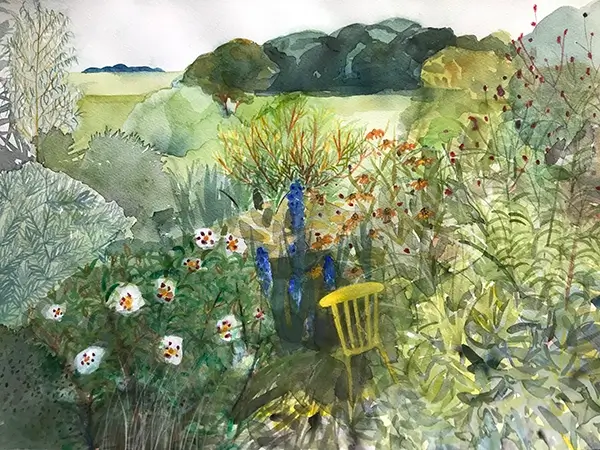
CLAUDIA SILVA
Gardens of Great Glemham
Suffolk’s famously dry, realist poet George Crabbe lived in Great Glemham at the turn of the 18th and 19th centuries. His son George later described the time he spent in the village as a child as the ‘Alhambra’ of his existence. In a biography of his father’s life he also gave accounts of the family following his father along local footpaths as he read to them from books – or going out from their house into the garden to tend their ‘plats’.
Crabbe was a keen botanist as well as a poet. He lived at a time in which the work of Carl Linnaeus was inspiring many to undertake their own personal taxonomic research into wild plants and animals. Crabbe compiled a plant list for the area which, as noted above, survives as an appendix in a History of Framlingham and its District published in 1806. In reading his son’s biography, it is both engaging and moving to picture the family walking along local lanes or tending to their individual beds in the shared garden of their home in the centre of the village
Today, in the early 21st century, Great Glemham still feels like a village of gardens. The soil is deep and fertile. Most of the farm land is what might be called ‘meadow land’: a soft, comfortable mix of loam and sand that covers the middle slopes of the small valleys that surround the village. Above this, on the ‘topland’, the soil changes to heavy clay. And lower down, it shifts from loam to sand; and then alluvial soils and peat in the floodplain. There is, in effect, a soil for all seasons. And on slopes with a southerly aspect, of which there are many, the earth is generously warmed by the sun, when it chooses to shine.
The largest of the gardens in the village are those around Great Glemham House, now in the care of my brother [and architect] Argus and my sister-in-law [and gardener / writer] Tilly. Miraculously, the gardens, covering over 12 acres, have survived almost intact in a layout and design that was first conceived in the early 19th century. It is a thoughtfully planned and abundantly productive combination of a walled kitchen garden, herbaceous borders, lawns and shrubberies. The survival of all components of the house – its family quarters, its service wing, walled garden, shrubberies, park, lake and winding drive – seems to be very rare, if not unique, in the East of England.
Beyond the boundaries of Great Glemham House and the adjoining Timber Yard Farm, and tucked behind walls, hedges and homes all around the village, are many other private gardens of varying sizes, each reflecting the history of the dwelling of which they are part and the botanical or culinary interests of past and present owners. Overall, it feels like a rich tapestry to explore. To this end, we are very excited to be working with the artist and gardener Claudia Silva, whose paintings we first showed at the farm in 2024.
As with Ian Sedge, we are delighted to be collaborating with a new artist on a theme that seems so resonant not just with the local landscape but also with East Anglia’s rich heritage of artists who are gardeners or keen botanists, or artists whose work often featured views of their gardens : Sir Cedric Morris, John Nash, Richard Chopping, John Morley, Mary Potter, Mary Fedden and Margaret Thomas all come to mind.
For this year’s Spring Festival Exhibitions, we are presenting a selection of over 15 new oil paintings and watercolours by Claudia. Some are from her own studio or garden, looking out from the village centre into the adjoining Vale of Great Glemham. Others are from the gardens of nearby neighbours and the walled garden of Great Glemham House. As her work gains confidence, it pleasing to see it begin to gain the broader recognition it so richly deserved.
As with Ian, this presentation of beautiful new watercolours and oil paintings by Claudia for the 2025 Alde Valley Spring Festival will pave the way to a larger solo show in the summer of 2026.
If you would like more information about Claudia’s paintings, including commissions, please email us at : enquiries@aldevalleyspringfestival.co.uk
~
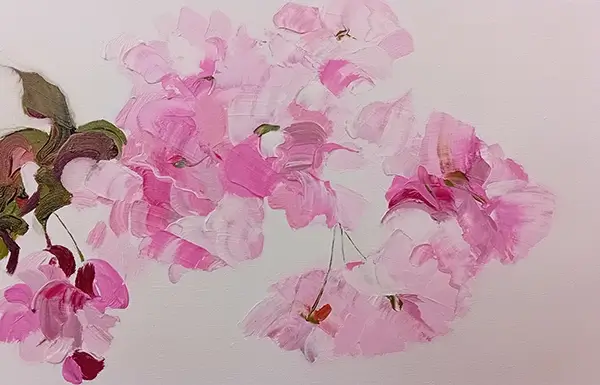
EMMA GREEN
The Cherry Ingram Blossom Residency
We have over sixty young flowering cherry trees growing at the farm, with a blossom season that extends from mid March to mid May. The season starts with Prunus Okame, swiftly followed by Prunus Kursar, Prunus Collingwood Ingram and an explosion of blossom on Prunus Pink Perfection. Other larger trees soon follow including : Prunus Yedoensis, Korean Hill Cherry, Prunus Taihaku, Prunus Matsumae Fuki / Chocolate Ice, Prunus Shizuka / Fragrant Cloud, Prunus Hokusai and Prunus Shirofugen.
The original inspiration for this collection of trees was a childhood memory of an ancient cherry that grew in the garden of my mother’s childhood home, Doddington Hall in Lincolnshire. My uncle Anthony gathered a gang of children under the boughs of the tree – my brother, sister and myself together with some of our cousins. He then shook the blossom-laden branches. All of us children found ourselves standing in a thick blizzard of tumbling soft pink petals. It was a truly magical experience, which I wanted to somehow recreate at the farm for myself, guests and family.
In the early years of the Alde Valley Spring Festival, we used to tie bright green, pink and yellow ribbons to trees on the front drive and upon archways in the barns. These were a substitute for cherry blossom. As years passed, we began to plant real flowering cherries bought from Jon Rose and his team at Botanica Nurseries near Campsea Ashe in East Suffolk. These were joined by potted trees kindly loaned to us by Jon for our Spring openings.
One year, as we added more trees to our collection, Jon asked if my interest in Japanese flowering cherries was “from the Kent connection”. I was in a hurry and didn’t really take on board or understand the question. I let it pass. It took several more years for the connection to be revealed – by the poet and garden writer Tim Richardson, whom I had been introduced to by a wonderful and generous friend, Daphne Astor.
Tim was staying at the farm on a writing residency. He referred me to a book by the writer Naoko Abe and explained that two cherry trees growing in the garden of a house called the Grange in Benenden, Kent, had inspired a life long passion for flowering cherries in someone called Collingwood ‘Cherry’ Ingram.
Collingwood Ingram had bought the Grange in the autumn of 1919.
The following spring, two large cherry trees in the garden of his new home burst into an abundance of thick pink blossom. Ingram was unable to identify the variety, even after consulting widely in the UK and Japan. He gave himself the freedom to create a name for the trees and chose Prunus Hokusai, after the famous Japanese woodblock printer.
The story is more fully explained in the book Cherry Ingram ~ The Englishman who Saved Japan’s Blossoms by the journalist and writer Naoko Abe. It happened that the Grange in Benenden was built by an ancestor of mine – my great, great grandfather the 2nd Earl of Cranbrook – who quite possibly planted the two cherry trees.
In 2020 we had the great honour of welcoming Naoko Abe and her husband Paul to the farm, as well as relatives and descendants of Collingwood Ingram. Through Naoko, we have been able to make contact with Mr Masatoshi Asari from Hokkaido. Now in his 90s, Mr Asari has created over 100 varieties of Matsumae cherry trees, which he has shared around the world in the spirit of peace and reconciliation. We are slowly adding more Matsumae varieties to our cherry collection at the farm, following Mr Asari’s suggestions, with additional help from Chris Lane in Kent and Nick Dunn from FP Matthews.
We started a Cherry Blossom Painting Residency with Emma Green in 2018. Over the years, it has grown and shifted in focus as we became aware of the connections to Collingwood Ingram, and, more recently, to Mr Asari. In 2020, we renamed it the Cherry Ingram Blossom Residency and have had the great pleasure of continuing the collaboration with Emma over the past five years, welcoming new collections of her blossom paintings each spring.
For 2025, we will be showing a small collection of new blossom paintings from Emma’s residency, with the last flowers from this year’s sakura still on some of the trees outside. With their connections to cherry tree varieties created by Collingwood Ingram and Mr Masatoshi Asari, Emma’s blossom paintings have become part of the rich history of Japanese flowering cherries grown in the UK. We look forward to presenting them to visitors, as a prelude to a collaboration with Emma and the taiko drummer and composer Joji Hirota in spring 2026.
If you would like more information about Emma’s paintings, please email us at : enquiries@aldevalleyspringfestival.co.uk
~
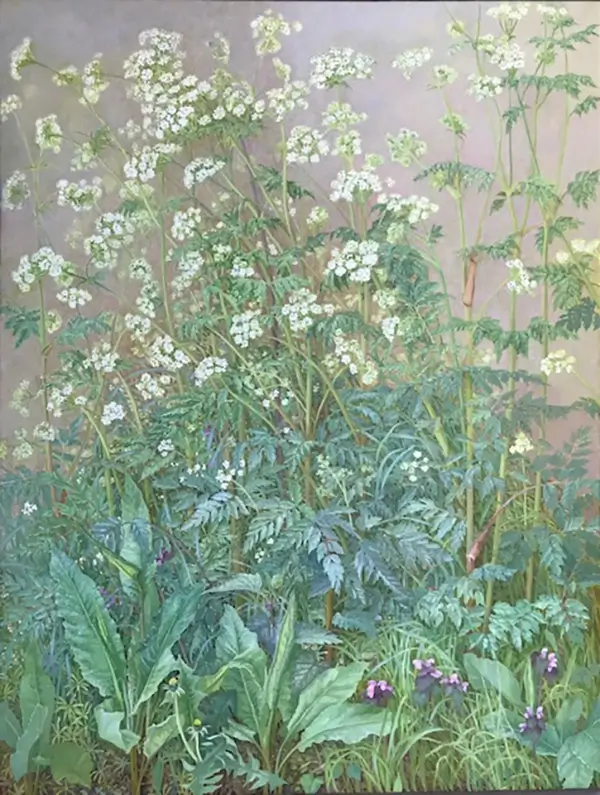
JANE WORMELL
The Hedgerow Residency – Holly Tree Field
In managing White House Farm for the past 25 years, one abiding aim has been to enhance and restore biodiversity across the land in our care : the arable fields, grassland, ditches, flood meadows, woodland, ponds, river and hedgerows.
Of these features in the landscape, hedgerows have been of particular interest over the past 12 years. During this time, we have been testing eight different types of hedgerow management : from simple, widened hedges set between fence lines to ‘deluxe’ versions with extra wide hedges bordered on one or both sides by scrub or wildflower margins.
One of the smallest fields on the farm is called Holly Tree. Along its north edge is a short section of hedgerow that happens to be one of the most botanically rich hedges in the parish : a fantastic mixture of hawthorn, blackthorn, hazel, rose, elder, oak, poplar, maple, ash with myriad herbs and shrubs growing through its base – or the ‘brew’ as it is locally known.
The field itself is partly shaded by a nearby wood. In typical Suffolk fashion, its soil varies from heavy clay along its upper western headland through clay loam and loam to sand along its lower eastern boundary. It was not very productive as an arable field and I never had much interest in it until I decided to take it out of arable crop rotations in 2008.
In the first autumn, I hand-seeded ox eye daisies along the northern edge and watched where the shadow line of the wood fell on the bare ground during the cold winter months. The following spring, I decided to use the sunny areas of the field as a market garden. Over subsequent years this has been tended various tenants and growers. The increase in the diversity of land uses on the field has been matched by a staggering increase in wild native plant species.
The field has taught me a lot about what does and what doesn’t work, in terms of market gardening and growing food. Good soil, good natural sunlight, an easy supply of water and minimal distances between tool stores, propagating areas and productive beds are all critical factors.
The mico-diversification of land use has also become a fascinating process to explore. A field that once grew one rather poor arable crop each year now supports Christmas trees, an osier bed, four bee hives, currants, raspberries, rhubarb, a small quiet area for retreats, a poly tunnel and water tank, compost heaps, apple trees, self-sown birch trees and a row of rugosa roses.
Most remarkable of all, a botanical survey very kindly undertaken by friends last year revealed that the market garden area is now also home to over 100 species of plants : 103 to be exact; and most of these are wild. This feels quite extraordinary – for a field that was used to grow one arable plant a year up until just seventeen years ago.
In developing the land-based arts residency programme at the farm over the past few years, we have been very fortunate to be able to work with the painter Jane Wormell. Our initial focus was on the farm’s hedgerows and their biodiversity, but in 2024 Jane quietly shifted her focus from hedges to plants growing in the middle of fields – and especially those found on Holly Tree field.
The resulting paintings are quite exquisite. They have a mesmerising, meditative quality to them : a beautiful serenity. In their detail, they are also botanically very accurate. They capture the wonderful abundance of plant life that now inhabits Holly Tree field. All of which makes Jane’s paintings doubly or even triply engaging. They celebrate the botanical diversity and ecological recovery of a landscape.
We very much look forward to welcoming a room full of new paintings from the Hedgerow Residency for the Spring Festival Exhibition.
If you would like more information about Jane’s paintings, including commissions, please contact us at : enquiries@aldevalleyspringfestival.co.uk
~
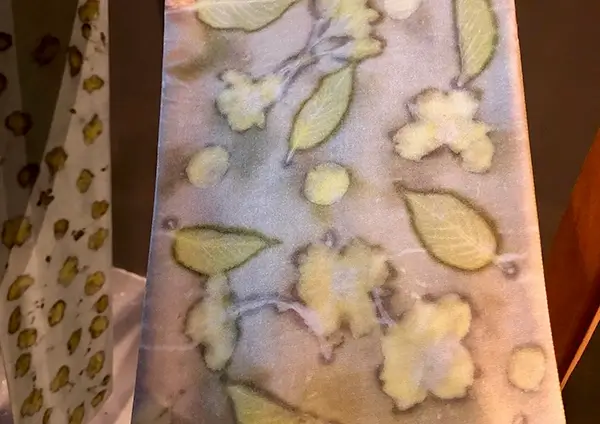
JENNY NUTBEEM
A Suffolk Sakura
Our residency collaboration with Jenny Nutbeem began several years ago with a walk around the pastures at White House Farm. Our original plan was to explore paper making and botanical printing, using plant materials gathered from the fields and headlands that surround the farmhouse.
Our walk veered off into a nearby wood called Rookyard Belt, which is home to the farm’s only population of truly wild cherry trees – all others seem to have been planted at some point in the past. There are only a few of these wild trees. All of them are tall and thin with meandering trunks, growing under much larger oaks, sweet chestnuts and sycamores. In reaching upwards to the light, their stems have become long and leggy, growing sideways as much as upwards in order to reach pockets of sunshine.
One tree had collapsed on to the ground and died. As its trunk had slowly rotted, layers of bark had peeled off like strips of dark, shiny leather. Jenny collected some, to see what sort of colour it might yield if used as a natural dye. To her surprise, the bark gave a beautiful golden brown colour. This prompted her to look at the young Japanese flowering cherries that are dotted around the farmyards and to wonder whether dyes and botanical prints made from the blossom and leaves of these trees could be combined with the rich golden colour derived from the bark of the fallen wild cherry tree in the woods.
The results were stunning : a small collection of sumptuous silk scarves and smaller samples of fabric, all printed and dyed with blossom and leaves gathered from the flowering cherry trees at the farm, combined in some cases with the dye from the bark of the fallen wild cherry, as well as pigments extracted from other plants found in nearby fields and hedgerows.
Over the intervening years, the focus of Jenny’s residency collaboration has shifted from textiles and natural dyes in general to seasonal collections of Suffolk Sakura Silk Scarves. These are all made with leaves and blossom carefully picked from the farm’s flowering cherry trees. The spring collections feature tumbling blossom, all caught in beautifully dyed designs on narrow lengths of silk. In turn, the autumn collections feature leaves from the many different varieties of cherry trees now growing here.
The flowering cherry trees have their own heritage. Almost all of the varieties now growing at the farm are connected to the lives of Collingwood Ingram and Mr Masatoshi Asari – two of the world’s great cherry guardians of the 20th and 21st centuries. Jenny’s wonderful Suffolk Sakura Silk Scarves celebrate this heritage. They are luxurious garments, as well as works of art. They capture a little piece of the history Japanese flowering cherries in the UK.
For this year’s Alde Valley Spring Festival, we are very excited to welcome a small collection of new creations from Jenny’s studio, all made with blossom collected from the 2025 flowering season.
If you would like more information about Jenny’s Suffolk Sakura Silk Scarves, including commissions, please contact us at : enquiries@aldevalleyspringfestival.co.uk
~
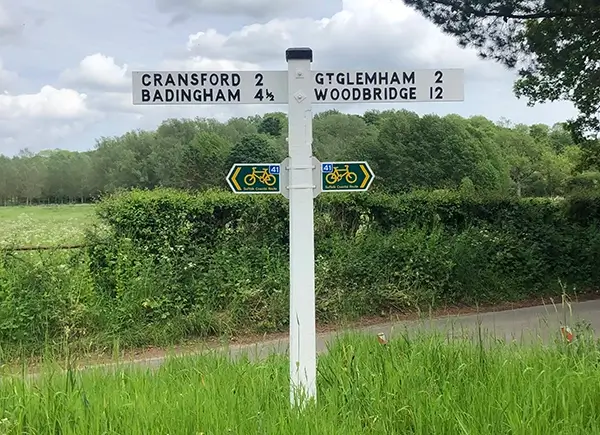
PLACES TO MEET & EAT NEARBY
~
We recommend all of the following for food and drinks. Please check the web-links provided for opening times
~
The Crown Inn – Great Glemham – IP17 2DA
thecrowninnglemham.co.uk
~
Juniper Barn – Rendham – IP17 2AZ
facebook.com/juniperbarncafeanddeli/
~
White Horse – Sweffling – IP17 2BB
swefflingwhitehorse.co.uk
~
White Horse – Rendham – IP17 2AF
rendhamwhitehorse.co.uk
~
The Suffolk – Aldeburgh High Street
the-suffolk.co.uk
~
Watson & Walpole, Framlingham
watsonandwalpole.com
~
Station Inn, Framlingham
thestationframlingham.com
~
Black Dog Deli, Yoxford
theblackdogdelis.co.uk/yoxford-deli
~
Common Room, Framlingham
facebook.com/commonroomfram
~
Pinch, Maple Farm, Kelsale
eatpinch.com
~
Magpie Bakery, Framlingham
twomagpiesbakery.co.uk/framlingham
~
LOCAL FOOD SHOPS
An excellent choice of food shops and delis can be found further afield in local villages, market towns and coastal settlements including Framlingham, Yoxford, Peasenhall, Saxmundham, Snape, Walberswick, Southwold, Thorpeness, Dunwich, Aldeburgh, Orford and Woodbridge. These are some of our local delicatessens and farm shops.
~
Leo’s Deli, Framlingham
leosdeli.co.uk
~
The Black Dog Deli, Yoxford
theblackdogdelis.co.uk/yoxford-deli
~
Friday Street Farm Shop, Snape
fridaystfarm.co.uk
~
East of England Co Op in Framlingham
eastofengland.coop/supermarket/framlingham
~
Grange Farm Shop, Hasketon
grangefarmshop.co.uk
~
Slate, Aldeburgh
bigbarn.co.uk/producer/aldeburgh/slate-deli-28299
~
Aldeburgh Market
thealdeburghmarket.co.uk
